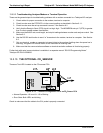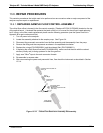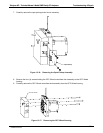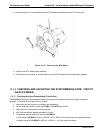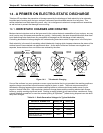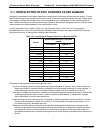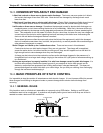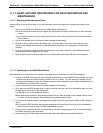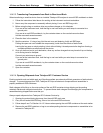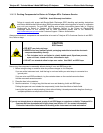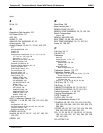
A Primer on Electro-Static Discharge Teledyne API – Technical Manual - Model 300E Family CO Analyzers
306
14.2. HOW ELECTRO-STATIC CHARGES CAUSE DAMAGE
Damage to components occurs when these static charges come into contact with an electronic device. Current
flows as the charge moves along the conductive circuitry of the device and the typically very high voltage levels
of the charge overheat the delicate traces of the integrated circuits, melting them or even vaporizing parts of
them. When examined by microscope the damage caused by electro-static discharge looks a lot like tiny bomb
craters littered across the landscape of the component’s circuitry.
A quick comparison of the values in Table 14-1 with the those shown in the Table 14-2, listing device
susceptibility levels, shows why Sem
i
conductor Reliability News estimates that approximately 60% of device
failures are the result of damage due to electro-static discharge.
Table 14-2: Sensitivity of Electronic Devices to Damage by ESD
DAMAGE SUSCEPTIBILITY VOLTAGE
RANGE
DEVICE
DAMAGE BEGINS
OCCURRING AT
CATASTROPHIC
DAMAGE AT
MOSFET 10 100
VMOS 30 1800
NMOS 60 100
GaAsFET 60 2000
EPROM 100 100
JFET 140 7000
SAW 150 500
Op-AMP 190 2500
CMOS 200 3000
Schottky Diodes 300 2500
Film Resistors 300 3000
This Film Resistors 300 7000
ECL 500 500
SCR 500 1000
Schottky TTL 500 2500
Potentially damaging electro-static discharges can occur:
Any time a charged surface (including the human body) discharges to a device. Even simple contact of a
finger to the leads of a sensitive device or assembly can allow enough discharge to cause damage. A
similar discharge can occur from a charged conductive object, such as a metallic tool or fixture.
When static charges accumulated on a sensitive device discharges from the device to another surface such
as packaging materials, work surfaces, machine surfaces or other device. In some cases, charged
device discharges can be the most destructive.
A typical example of this is the simple act of installing an electronic assembly into the connector or wiring
harness of the equipment in which it is to function. If the assembly is carrying a static charge, as it is
connected to ground a discharge will occur.
Whenever a sensitive device is moved into the field of an existing electro-static field, a charge may be
induced on the device in effect discharging the field onto the device. If the device is then momentarily
grounded while within the electrostatic field or removed from the region of the electrostatic field and
grounded somewhere else, a second discharge will occur as the charge is transferred from the device to
ground.
04288D DCN5752



